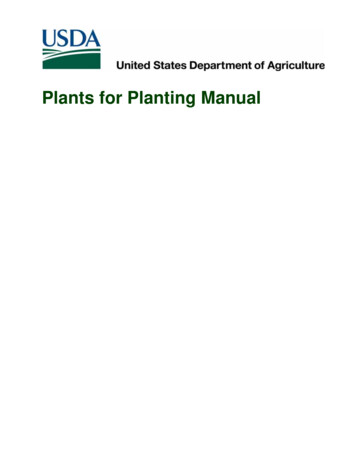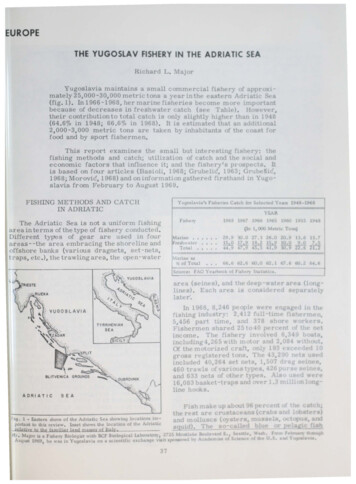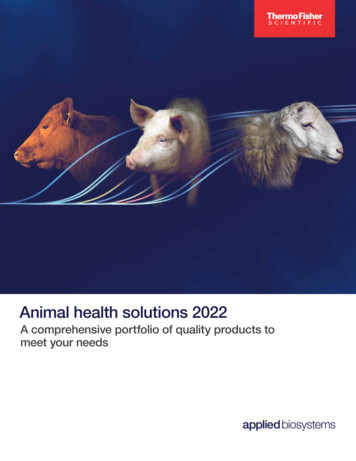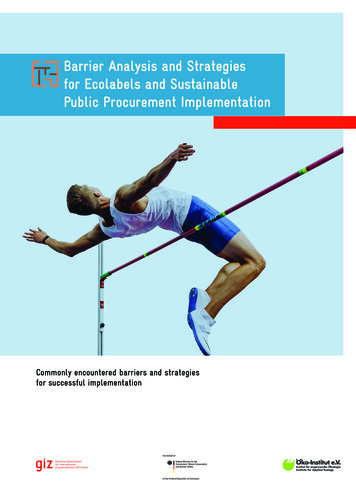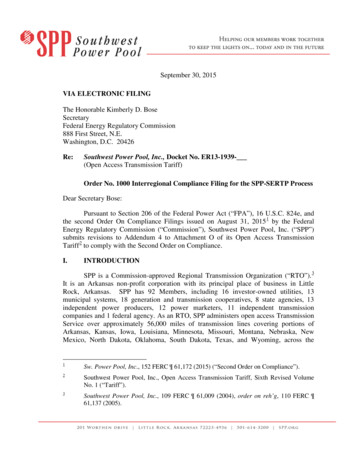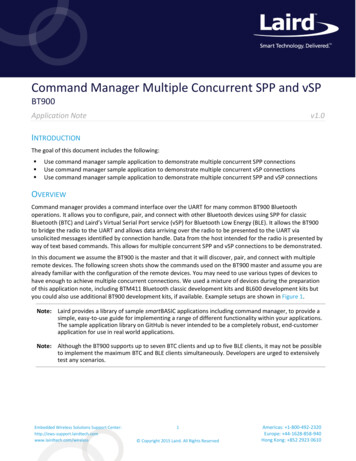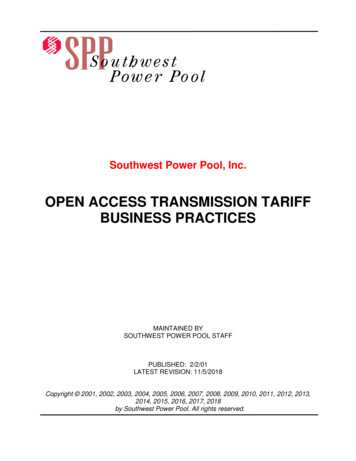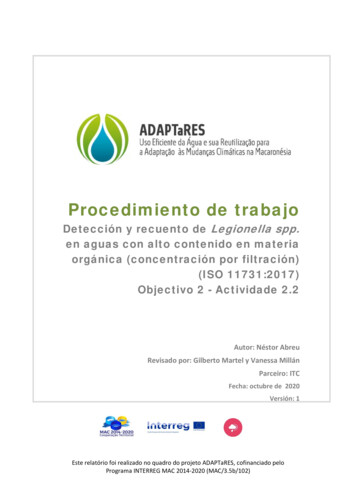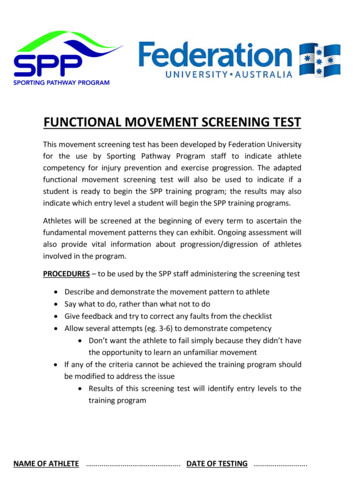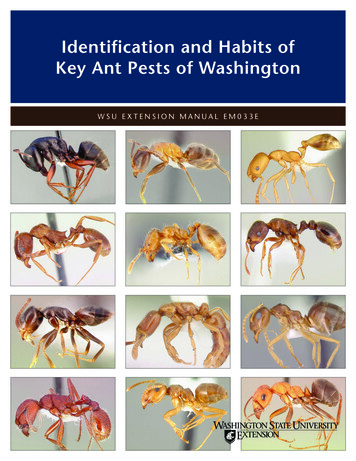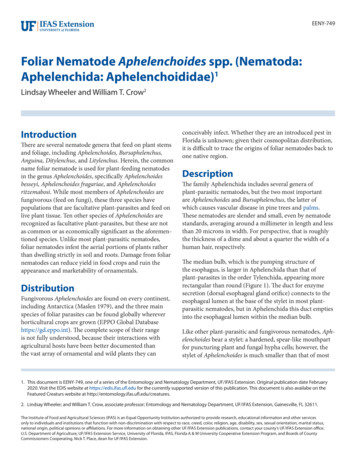
Transcription
EENY-749Foliar Nematode Aphelenchoides spp. (Nematoda:Aphelenchida: Aphelenchoididae)1Lindsay Wheeler and William T. Crow2IntroductionThere are several nematode genera that feed on plant stemsand foliage, including Aphelenchoides, Bursaphelenchus,Anguina, Ditylenchus, and Litylenchus. Herein, the commonname foliar nematode is used for plant-feeding nematodesin the genus Aphelenchoides, specifically Aphelenchoidesbesseyi, Aphelenchoides fragariae, and Aphelenchoidesritzemabosi. While most members of Aphelenchoides arefungivorous (feed on fungi), these three species havepopulations that are facultative plant-parasites and feed onlive plant tissue. Ten other species of Aphelenchoides arerecognized as facultative plant-parasites, but these are notas common or as economically significant as the aforementioned species. Unlike most plant-parasitic nematodes,foliar nematodes infest the aerial portions of plants ratherthan dwelling strictly in soil and roots. Damage from foliarnematodes can reduce yield in food crops and ruin theappearance and marketability of ornamentals.DistributionFungivorous Aphelenchoides are found on every continent,including Antarctica (Maslen 1979), and the three mainspecies of foliar parasites can be found globally whereverhorticultural crops are grown (EPPO Global Databasehttps://gd.eppo.int). The complete scope of their rangeis not fully understood, because their interactions withagricultural hosts have been better documented thanthe vast array of ornamental and wild plants they canconceivably infect. Whether they are an introduced pest inFlorida is unknown; given their cosmopolitan distribution,it is difficult to trace the origins of foliar nematodes back toone native region.DescriptionThe family Aphelenchida includes several genera ofplant-parasitic nematodes, but the two most importantare Aphelenchoides and Bursaphelenchus, the latter ofwhich causes vascular disease in pine trees and palms.These nematodes are slender and small, even by nematodestandards, averaging around a millimeter in length and lessthan 20 microns in width. For perspective, that is roughlythe thickness of a dime and about a quarter the width of ahuman hair, respectively.The median bulb, which is the pumping structure ofthe esophagus, is larger in Aphelenchida than that ofplant-parasites in the order Tylenchida, appearing morerectangular than round (Figure 1). The duct for enzymesecretion (dorsal esophageal gland orifice) connects to theesophageal lumen at the base of the stylet in most plantparasitic nematodes, but in Aphelenchida this duct emptiesinto the esophageal lumen within the median bulb.Like other plant-parasitic and fungivorous nematodes, Aphelenchoides bear a stylet: a hardened, spear-like mouthpartfor puncturing plant and fungal hypha cells; however, thestylet of Aphelenchoides is much smaller than that of most1. This document is EENY-749, one of a series of the Entomology and Nematology Department, UF/IFAS Extension. Original publication date February2020. Visit the EDIS website at https://edis.ifas.ufl.edu for the currently supported version of this publication. This document is also availabe on theFeatured Creaturs website at http://entomology.ifas.ufl.edu/creatures.2. Lindsay Wheeler; and William T. Crow, associate professor; Entomology and Nematology Department, UF/IFAS Extension, Gainesville, FL 32611.The Institute of Food and Agricultural Sciences (IFAS) is an Equal Opportunity Institution authorized to provide research, educational information and other servicesonly to individuals and institutions that function with non-discrimination with respect to race, creed, color, religion, age, disability, sex, sexual orientation, marital status,national origin, political opinions or affiliations. For more information on obtaining other UF/IFAS Extension publications, contact your county’s UF/IFAS Extension office.U.S. Department of Agriculture, UF/IFAS Extension Service, University of Florida, IFAS, Florida A & M University Cooperative Extension Program, and Boards of CountyCommissioners Cooperating. Nick T. Place, dean for UF/IFAS Extension.
other plant-parasites (Figure 1). Their stylets have smallbasal knobs, a feature that can be used to separate themfrom the closely related fungivorous genus Aphelenchus,which lacks knobs. Aphelenchoides reproduce primarilyby amphimixis, and males are common. The vulva of thefemale is located near 2/3 the body length from the anterior.Females have a single, prodelphic (anteriorly outstretched)ovary and a post-uterine sac, while males have prominent,thorn-shaped spicules (paired, cuticularized copulatorystructures) (Figure 2).physical feature of Aphelenchoides is the mucro, whichis a miniscule projection from the tip of the nematode’stail (Figure 3). Different species may have a mucro with asingle-pointed tip or one that flares into multiple points,and this is commonly used as a diagnostic feature. Foliarnematodes tend to exhibit far more physical activity thantheir soil-dwelling, plant-parasitic counterparts. Numerous,rapidly undulating roundworms (as seen in this video)can be extracted by allowing shredded leaves to soak inwater for a day or two, but a microscope is still necessaryto observe them. If species identification in needed, theUF/IFAS Nematode Assay Lab can identify Aphelenchoidesand other nematodes to species using morphological andmolecular methods.Figure 3. Three-pointed mucro on the tail tip of Aphelenchoidesbesseyi.Credits: Lindsay Wheeler, UF/IFASLife Cycle and BiologyFigure 1. Anterior of an aphelenchid nematode, Aphelenchoides besseyi(A) and a tylenchid nematode, Hoplolaimus sp. (B). The median bulb(M) of aphelenchids are larger and more square-shaped than those oftylenchids. The stylet (S) of aphelenchids and other fungivores tend tobe smaller than those of most obligate plant-parasites.Credits: Lindsay Wheeler (A), and William T. Crow (B), UF/IFASFigure 2. Reproductive organs of Aphelenchoides besseyi. Females (A)of Aphelenchoides sp. lack the vulval flap found in Bursaphelenchussp. Males (B) of Aphelenchoides sp. lack the bursa found inBursaphelenchus sp.Credits: Lindsay Wheeler, UF/IFASThe females and males of Aphelenchoides differ from theirother close relative, Bursaphelenchus, by lacking a vulvalflap and bursa (copulatory grasping structures), respectively(Figure 2). A distinctive, though difficult to observe,On plants, foliar nematodes are known to feed bothectoparasitically (on the host surface) or endoparasitically(within plant tissue). As ectoparasites, foliar nematodesoften inhabit the tightly folded tissue of leaf and flowerbuds. As endoparasites, they enter leaves through openstomata to lay eggs among the cells of the mesophyll. Aswith all nematodes, Aphelenchoides molt their cuticle oncewhile still in their egg and three more times before reachingadulthood. The second-stage juveniles (J2) hatch and beginfeeding on the surrounding cells. Once foliar nematodesgrow to the fourth-stage juvenile (J4) or adult stage, theycan migrate out of the leaf and travel across the outside ofthe plant when a film of water is present, such as after rain,irrigation, or morning dew (Wallace 1960).Some of the migrating nematodes may be splashed ontoneighboring plants, reinfest the original plant in a differentlocation, or travel upward toward the plant’s reproductivestructures (flowers, panicles, etc.). Although they rely onmoisture for active dispersal, foliar nematodes are welladapted to survive when conditions are very dry (desiccation). If allowed to desiccate gradually, these nematodescan remain dormant in seeds or dry plant tissue until theyare rehydrated by moist conditions, thereby returning to anFoliar Nematode Aphelenchoides spp. (Nematoda: Aphelenchida: Aphelenchoididae)2
active and infective state (French and Barraclough 1962).The rice white tip foliar nematode Aphelenchoides besseyiand the chrysanthemum foliar nematode Aphelenchoidesritzemabosi have been shown to remain viable in this stateof anhydrobiotic dormancy for 20 to 36 months (Frenchand Barraclough 1962; Huang and Huang 1974).HostsFoliar nematodes have been documented in associationwith over 700 species of plants, which include at least 126families spanning monocots and dicots, gymnosperms andangiosperms, and even ferns, liverworts, and clubmosses(Sánchez-Monge 2015). The host ranges of individualAphelenchoides species often overlap, and thus one plantgroup may be a suitable host for multiple species of foliarnematode (Kohl 2011). In addition to plant hosts, foliarnematodes are capable of feeding on fungi. This unusualdegree of dietary diversity can make management challenging, because methods such as crop rotation will not denythese nematodes a food source.Economic ImportanceWhile having to replace plants in a landscape or smallgarden is frustrating, foliar nematodes create far moreexpensive problems in nursery production and food crops.The practical and economic importance of food productionmay be intuitive, but the 4.6 billion in wholesale value thatthe US floriculture (non-agricultural plant production)industry generates is also worth noting (Anonymous 2019).Foliar nematodes can spread rapidly through operationswhere plants are somewhat crowded and are irrigated byoverhead sprinklers.It has been reported that certain organophosphate andcarbamate insecticides previously used in nurseriesprovided incidental control of foliar nematodes (Jagdaleand Grewal 2002); however, most of these pesticides are nolonger registered for use on floricultural crops, so outbreaksof foliar nematodes are becoming more common. Similarly,recent outbreaks of crimp disease (described below) inFlorida strawberry production has been attributed to theloss of methyl bromide fumigation as a management optionin transplant nurseries (Desaeger and Noling 2017). Itis difficult to predict the financial impact that the loss ofthese management tools may have on the plant industryas a whole, and data regarding current losses is largelyunavailable.The most commonly encountered symptom of endoparasitic feeding is a patchwork browning of foliar tissue(Figure 4). This pattern suggests the nematodes are unableto burrow through leaf veins, requiring them to exit theleaf when food is exhausted within the vein-bordered areaand reenter the host elsewhere. The lesions left behind mayappear geometric, streak-like, or as speckles depending onthe venation patterns of the host plant. On ferns, browningof the pinnules may occur on only one side of the costas(Figure 5). Plants may also exhibit a lack of vigor due toheavy infestation, such as stunted growth and a thin canopy.Figure 4. Foliar nematodes cause vein-delimited discoloration, such asthe geometric lesions on these echinacea leaves.Credits: William T. Crow, UF/IFASFigure 5. On ferns, foliar nematodes can cause lesions confined toindividual pinnae or lobes of pinnae.Credits: William T. Crow, UF/IFASSymptoms may vary between host crops, even wheninfected with the same species of foliar nematode. Forexample, white tip disease of rice and green stem andfoliar retention syndrome of soybean are both caused byAphelenchoides besseyi (Figure 6). In rice, white tip diseaseinduces chlorotic whitening of the leaf tips, extending 3to 5 cm down the leaf, which is its diagnostic symptom.Damage to the panicles can result in a significant yieldloss (de Jesus et al. 2016). In Brazil, this same species hasbeen recently identified as a major pest of soybean, whereit disrupts harvest by causing plants to remain green whenthey should senesce (Meyer et al. 2017). In addition to asingle species causing different symptoms on two hosts,Foliar Nematode Aphelenchoides spp. (Nematoda: Aphelenchida: Aphelenchoididae)3
more than one species can be associated with a single hostAphelenchoides besseyi and Aphelenchoides fragariae areknown to cause crimping disease symptoms in strawberries,where the leaves grow crumpled and distorted, and the fruitis likewise stunted and deformed (Figure 7) (Desaeger andNoling 2017).Some success has been achieved using hot-water treatmentor a succession of wetting and rapid dehydration of seeds,such as with rice, but this is not feasible with all potentialhosts (Jagdale and Grewal 2004; Hoshino and Togashi2000). Very few pesticides are currently labeled for useagainst foliar nematodes, and research is ongoing todevelop new or reformulated products that can effectivelymanage outbreaks. Beyond rice, there does not appear tobe an effort to develop resistant plant cultivars, nor muchdata on what genes are involved with resistance to foliarnematodes.Selected ReferencesAnonymous. 2019. Floriculture Crops 2018 Summary(May 2019). National Agricultural Statistics Service. ISSN:1949-0917.Figure 6. White tip disease caused by Aphelenchoides besseyi, which ischaracterized by chlorotic leaf tips.Credits: E. C. McGawley, Louisiana State Universityde Jesus DS, Oliveira CMG, Roberts D, Blok V, NeilsonR, Prior T, Balbino HM, MacKenzie KM, Oliveira RDL.2016. “Morphological and molecular characterizationof Aphelenchoides besseyi and A. fujianensis (Nematoda:Aphelenchoididae) from rice and forage grass seeds inBrazil.” Nematology 18: 337–356.Desaeger J, Noling J. 2017. Foliar or Bud Nematodes inFlorida Strawberries. ENY-068. Gainesville, FL: Universityof Florida Institute of Food and Agricultural Sciences.https://edis.ifas.ufl.edu/in1184French N, Barraclough RM. 1962. “Survival of Aphelenchoides ritzemabosi (Schwartz) in soil and dry leaves.”Nematologica 7: 309–316.Figure 7. Strawberry leaf crimp caused by Aphelenchoides besseyi.Credits: William T. Crow, UF/IFASManagementLittle can be done to salvage a plant that is already infested,because the nematodes may have spread throughout thefoliage by the time the symptoms become noticeable.Presently, sanitation is the best means of halting the spreadof foliar nematodes. This means keeping plants well-spaced,using drip rather than overhead irrigation, and disposingof dead leaves rather than utilizing them as mulch orallowing them to remain underneath the plant canopy. It isalso important to be mindful of irrigation sources, becausepond-sourced irrigation may transport nematodes frominfested pond weeds.Hoshino S, Togashi K. 2000. “Effect of water-soaking andair-drying on survival of Aphelenchoides besseyi in Oryzasativa seeds.” Journal of Nematology 32: 303–308.Huang CS, Huang SP. 1974. “Dehydration and the survivalof rice white tip nematode, Aphelenchoides besseyi.” Nematologica 20: 9–18.Jagdale GB, Grewal PS. 2002. “Identification of alternativesfor management of foliar nematodes in floriculture.” PestManagement Science 58: 451–458.Jagdale GB, Grewal PS. 2004. “Effectiveness of a hot waterdrench for the control of foliar nematodes Aphelenchoidesfragariae in floriculture.” Journal of Nematology 36: 49–53.Kohl LM. 2011. “Foliar nematodes: A summary of biologyand control with a compilation of host range.” Plant HealthProgress. doi:10.1094/PHP-2011-1129-01-RV.Foliar Nematode Aphelenchoides spp. (Nematoda: Aphelenchida: Aphelenchoididae)4
Maslen NR. 1979. “Six new nematode species from themaritime Antarctic.” Nematologica 25: 288–308.Meyer M, Favoreto L, Klepker D, Marcelino-Guimarães FC.2017. “Soybean green stem and foliar retention syndromecaused by Aphelenchoides besseyi.” Tropical Plant Pathology42: 403–409.Sánchez-Monge A, Flores L, Salazar L, Hockland S, Bert W.2015. “An updated list of the plants associated with plantparasitic Aphelenchoides (Nematoda: Aphelenchoididae)and its implications for plant-parasitism within this genus.”Zootaxa 4013: 207–224.Wallace HR. 1960. “Observations on the behaviour ofAphelenchoides ritzemabosi in chrysanthemum leaves.”Nematologica 5: 315–321.Foliar Nematode Aphelenchoides spp. (Nematoda: Aphelenchida: Aphelenchoididae)5
in transplant nurseries (Desaeger and Noling 2017). It is difficult to predict the financial impact that the loss of these management tools may have on the plant industry as a whole, and data regarding current losses is largely unavailable. The most commonly encountered symptom of endo-parasitic feeding is a patchwork browning of foliar tissue

